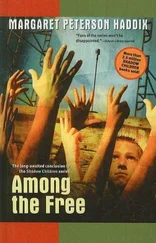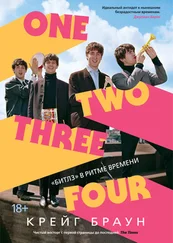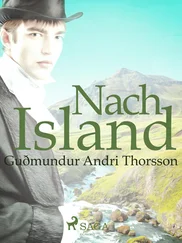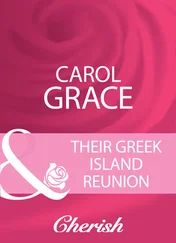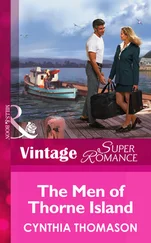The chill penetrates the soles of her boots, making first her feet and then her legs feel very cold. She ought to have stuffed her boots with straw as she remembered reading about people doing in the Alps. Though there wouldn’t have been room for much straw in her already too-tight boots.
Stephie stops to check her direction again. Feeling around in her knapsack for the compass, she can’t find it. She takes everything out-her sandwiches and schoolbooks-shaking the sack upside down. The compass just isn’t there. She must have forgotten it when she stopped to eat.
She turns around and sees the islet far behind her. Should she go back? That would take at least half an hour, and then another half hour to return to this spot. If she just continues straight ahead, she can probably manage without the compass.
The expanse of ice seems never-ending. Now Stephie is cold through and through, in spite of her heavy sweater and double stockings. She eats the last sandwich as she walks. The milk in her bottle has frozen to a white slush.
The worst part is that it’s already getting dark. The dusky air is blue, and her shadow on the ice is eerily long and thin. It looks like she’s on stilts.
Night falls quickly. Soon she won’t be able to see at all. If she stops where she is, she will freeze to death during the night. The snow creaks, and the ice makes clicking sounds. In the far distance she sees the flashing red light of a lighthouse.
When it is nearly pitch black, she sees the contours of land ahead. She begins to hurry. Exhausted and freezing cold, she steps back onto land. She’s standing on a stony beach. To the right there’s a dock and a boathouse…
Stephie raises her gaze. Straight ahead she sees a white house with high stone steps. It’s a house she recognizes.
She must have walked in a circle instead of straight ahead, turning back out to sea instead of toward the mainland as she thought. She walked right around the island in such a wide arc she couldn’t see it until she swung around again and struck land on the west side. The lighthouse she saw must have been the same one she usually sees from the top of the hill.
Her whole long trek was completely in vain. She’s back where she started. She hasn’t been able to do a thing to help her mother and father, not a single thing.
The kitchen window is bright. When she opens the front door she smells fried pork.
“Stephie,” Aunt Märta calls from the kitchen, “is that you?”
Aunt Märta heats up the baked beans for her, scolding her for being late.
“For once you could try to keep track of the time,” she says. “Didn’t I tell you to be back for dinner?”
“I didn’t have any way of knowing what time it was,” Stephie replies.
“Were you at the sledding hill all this time?”
Stephie shakes her head. “No, we had a bit of a walk on the ice as well.”
“What a thing to do,” Aunt Märta says. “I hope you’re careful. There are places where the ice is very thin, you know.”
Stephie never tells anyone about her adventure on the ice. It’s a secret she intends to keep to herself. She picks up the sled on her way home from Sunday school, and explains to Aunt Märta that she left it at Britta’s overnight.
When Uncle Evert comes home Stephie fills him in about her father’s letter and what the woman from the relief committee said to Aunt Märta on the phone. To her surprise she hears Aunt Märta say:
“It’s not fair. There must be some solution.”
Uncle Evert sits thinking for a few minutes. “I could write to our member of parliament,” he says. “Maybe he can help.”
“Member of parliament? What’s that?” Stephie asks.
“Parliament,” Uncle Evert explains, “is where our decision makers work. There’s a member of parliament from these islands. He’s just a regular person you can talk to if you’re having a problem.”
Uncle Evert asks Stephie some questions about her parents before he drafts the letter. On the envelope he writes the man’s name and, on the line below, “Parliament of Sweden.” Stephie walks with him to the post office, where he mails it to Stockholm. The woman behind the counter looks impressed.
“So, you’re getting involved in politics, are you?” she asks.
“Sure am,” Uncle Evert answers.
When they’ve left the post office, Stephie and Uncle Evert have a good laugh about the curious look the woman gave him.
“She’d give anything to know what’s in that letter,” Uncle Evert says, chuckling.
Now Stephie waits eagerly not only for letters from her parents but also for an answer from Stockholm. She imagines it arriving in a long, narrow envelope with gold edging and the blue-and-yellow Swedish coat of arms. Inside there will be a letter saying that her parents are welcome to come live in Sweden.
The weeks pass and no answer arrives. The cold weather persists. At school the children keep their coats on. One Saturday in early March Miss Bergström tells the class the school is going to close for a few weeks as there isn’t enough fuel to keep the schoolhouse heated.
“We have to economize, what with the war,” she tells them. “So we’ll have a ‘fuel break’ until after Easter, when the weather should have warmed up.”
She gives them assignments to do at home, arithmetic problems to solve and spelling to work on.
Stephie misses school. The days pass so slowly. She’s in suspense, waiting for an answer from Stockholm, for school to start again, for spring to arrive.
***
Easter is early that year. The ocean is still frozen over; the island’s still covered with snow. The children and young people devote a lot of time during the week leading up to Easter to gathering wood and other things to burn, and carrying it all up to the highest point on the island, where the Easter bonfire will be.
“You have to be able to see the fire from a long way off,” Nellie explains to Stephie as they trudge up to the top of the hill with some scraps of wood. “So everyone will see our bonfire as the biggest one on any of the islands.”
The bonfire will be on Easter Eve, after sunset. At midday Stephie makes her usual trip to the post office. On the way, she sees some little old ladies, but they are not dressed in black as the old ladies on the island always are. These ladies are wearing brightly patterned skirts, aprons, and head scarves.
When she gets closer, she sees that they are children. Their long skirts are dragging on the ground. One of them is carrying a broomstick, the other a copper kettle. Their cheeks are rouged and their noses blackened with soot.
Not until she is almost on top of them does Stephie recognize Nellie and Sonja. What on earth are they doing?
“Give a coin to the Easter witches,” Sonja says, holding out her kettle.
Stephie’s furious. Her little sister, walking around the village begging, dressed in rags! Imagine if Mamma and Papa knew! She tears the flowery kerchief off Nellie’s head.
“Are you out of your mind?” she shouts. “Making a laughingstock of us for the whole island to see!”
“Stop it!” Nellie cries, pulling at the scarf. “Careful of that, it’s Auntie Alma’s.”
“Get out of those rags at once!” Stephie roars. “Go home and wash your face! You look like a beggar. What will people think?”
“You’re the one who’s out of her mind,” Nellie shouts back. “You’re dumb! We’re dressed up as Easter witches. But I don’t suppose you know what an Easter witch is. You think everything always has to be just like back home.”
“Sonja, Nellie?” other children’s voices shout. Three more little girls come running up. They’re dressed up, too, like Nellie and Sonja.
Читать дальше



